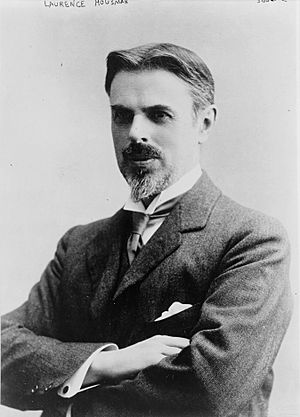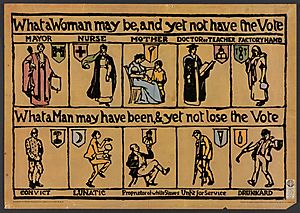Laurence Housman facts for kids
Laurence Housman (born July 18, 1865 – died February 20, 1959) was an English writer, playwright, and illustrator. He lived during the Victorian era and was the younger brother of the famous poet A. E. Housman. Laurence Housman was known for his many creative works and his strong support for women's rights.
Contents
Early Life and Education
Laurence Housman was born in Bromsgrove, England. He was one of seven children. His older brother was the poet A. E. Housman, and his sister, Clemence Housman, was also a writer. When Laurence was six years old, his mother passed away.
He went to Bromsgrove School and later studied art in London. He attended the Lambeth School of Art and the Royal College of Art.
Becoming an Illustrator
Laurence Housman started his career as an illustrator for books. He drew pictures for works like Christina Rossetti's Goblin Market (1893) and his sister's story The Were-Wolf (1896). His illustrations often used a detailed style called Art Nouveau. During this time, he also began writing his own poems and songs.
Writing Plays and Stories
Laurence Housman started focusing more on writing when his eyesight began to get worse. His first big success as a writer was the novel An Englishwoman's Love-letters (1900).
He became especially well-known as a playwright, writing many plays. One of his most famous plays was Victoria Regina (1934), which was even performed on Broadway in New York City. Some of his plays caused a stir because they showed characters from the Bible or members of the British Royal Family on stage. At the time, this was not allowed without special permission. For example, Victoria Regina could not be performed publicly in Britain until 1937, because of rules about showing the Queen on stage.
Housman also wrote many children's fairy tales, such as A Farm in Fairyland (1894). He wrote fantasy stories for adults too, often with Christian themes. He was a very busy writer, publishing about a hundred different works. These included everything from stories for kids to pamphlets about social issues like peace and fairness.
He wrote a book about his own life called The Unexpected Years (1937). After his brother A.E. Housman died in 1936, Laurence helped publish more of his brother's poems.
Working for Women's Rights
Laurence Housman was a strong supporter of women's rights, especially the Suffrage movement in England. This movement worked to get women the right to vote. He used his artistic talents to help the cause.
The Suffrage Atelier Studio
In 1909, Laurence Housman and his sister, Clemence Housman, started a studio called the Suffrage Atelier. This studio made art and posters to support the women's suffrage movement. It was special because it paid artists for their work by selling their creations to people who supported the cause. The studio also brought women together to work on projects like making banners, which helped them connect with each other.
A Hub for Feminism
Housman's home in London also became a meeting place for the women's rights movement. Besides housing the Suffrage Atelier, it hosted classes and invited speakers to help women explore their feminist ideas.
The 1911 Census Protest
In 1911, many women decided to protest the government by refusing to give their information for the national census. This was a way to show they were not counted as full citizens if they couldn't vote. Laurence Housman strongly supported this protest. He wrote articles for a newspaper called 'The Vote' encouraging women to join the boycott. He even used his house as a safe place for women who refused to participate in the census.
The Anti-Suffrage Alphabet
Housman also contributed illustrations to a book called The Anti-Suffrage Alphabet. This book helped raise money for the suffrage campaign. Its main goal was to challenge unfair ideas about women and criticize negative attitudes towards them.
Creating Banners and Writings
One of Housman's first banners for the movement was "From Prison to Citizenship." This banner was often used by the Women's Social and Political Union, a leading suffrage group.
As a writer, Housman used his skills to help the movement. He would often take existing works and give them a feminist twist. He also wrote for newspapers like The Women's Press and Votes for Women, giving advice on how to protest and sharing poems that supported the suffragettes.
The Power of Propaganda
Housman understood the power of propaganda, which means spreading ideas to support a cause. He used different ways to spread his message, including creating banners, the Anti-Suffrage Alphabet book, and writing for newspapers. He knew that repeating the same message through different media could make it very powerful.
Other Activism
Besides his artistic work, Housman also took part in physical protests. He often spoke at suffrage rallies, using his artistic style to make his speeches engaging. He also helped present a petition against force-feeding of imprisoned suffragettes and was arrested during a related protest.
Men Supporting Women's Suffrage
Housman believed that men should also be active in the suffrage movement. He helped form the Men’s League for Women’s Suffrage. This group successfully convinced some men to write "Vote for Women" on their ballots in the 1910 election.
Peace Activism
Laurence Housman was also a strong supporter of peace. In 1945, a bookshop called Housmans Bookshop was opened in his honor by the Peace Pledge Union, a group he supported. The shop still exists today and sells books about peace and other progressive ideas.
Later Life
After World War I, Laurence and his sister Clemence moved from London to a village called Ashley in Hampshire. Later, in 1924, they moved to Street, Somerset, where Laurence lived for the last 35 years of his life.
Remembering His Contributions
In 2018, Laurence Housman's name was included on the base of the statue of Millicent Fawcett in Parliament Square, London. This statue honors a leader of the women's suffrage movement, and Housman's name is there to recognize his important support for women's rights.
Images for kids
See also
 In Spanish: Laurence Housman para niños
In Spanish: Laurence Housman para niños





